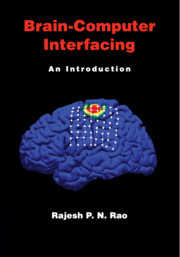Book contents
12 - Applications of BCIs
from Part IV - Applications and Ethics
Published online by Cambridge University Press: 05 October 2013
Summary
In this chapter, we explore the range of applications for BCI technology. We have already touched upon some medical applications such as restoration of lost motor and sensory function when we examined invasive and noninvasive BCIs in previous chapters. Here we briefly review these applications before exploring applications in other areas such as entertainment, robotic control, gaming, security, and art.
Medical Applications
The field of brain-computer interfacing originated with the goal of helping the paralyzed and the disabled. It is therefore not surprising that some of the major applications of BCIs to date have been in medical technology, particularly restoring sensory and motor function.
Sensory Restoration
One of the most widely used commercial BCIs is the cochlear implant for the deaf, discussed in Section 10.1.1. The cochlear implant is an example of a BCI for sensory restoration, as are retinal implants being developed for the blind (Section 10.1.2).
There has not been much research on two other possible types of purely sensory BCIs, namely, BCIs for somatosensation and BCIs for olfaction and taste. In the case of the former, the need for a BCI is minimized because it is ot en possible to restore tactile sensation through skin grafting. However, as we saw in Chapter 11, there is considerable interest in somatosensory stimulation as a component of bidirectional BCIs for allowing paralyzed individuals and amputees to, for example, sense objects being grasped or touched by prosthetic devices.
- Type
- Chapter
- Information
- Brain-Computer InterfacingAn Introduction, pp. 239 - 271Publisher: Cambridge University PressPrint publication year: 2013
- 1
- Cited by

